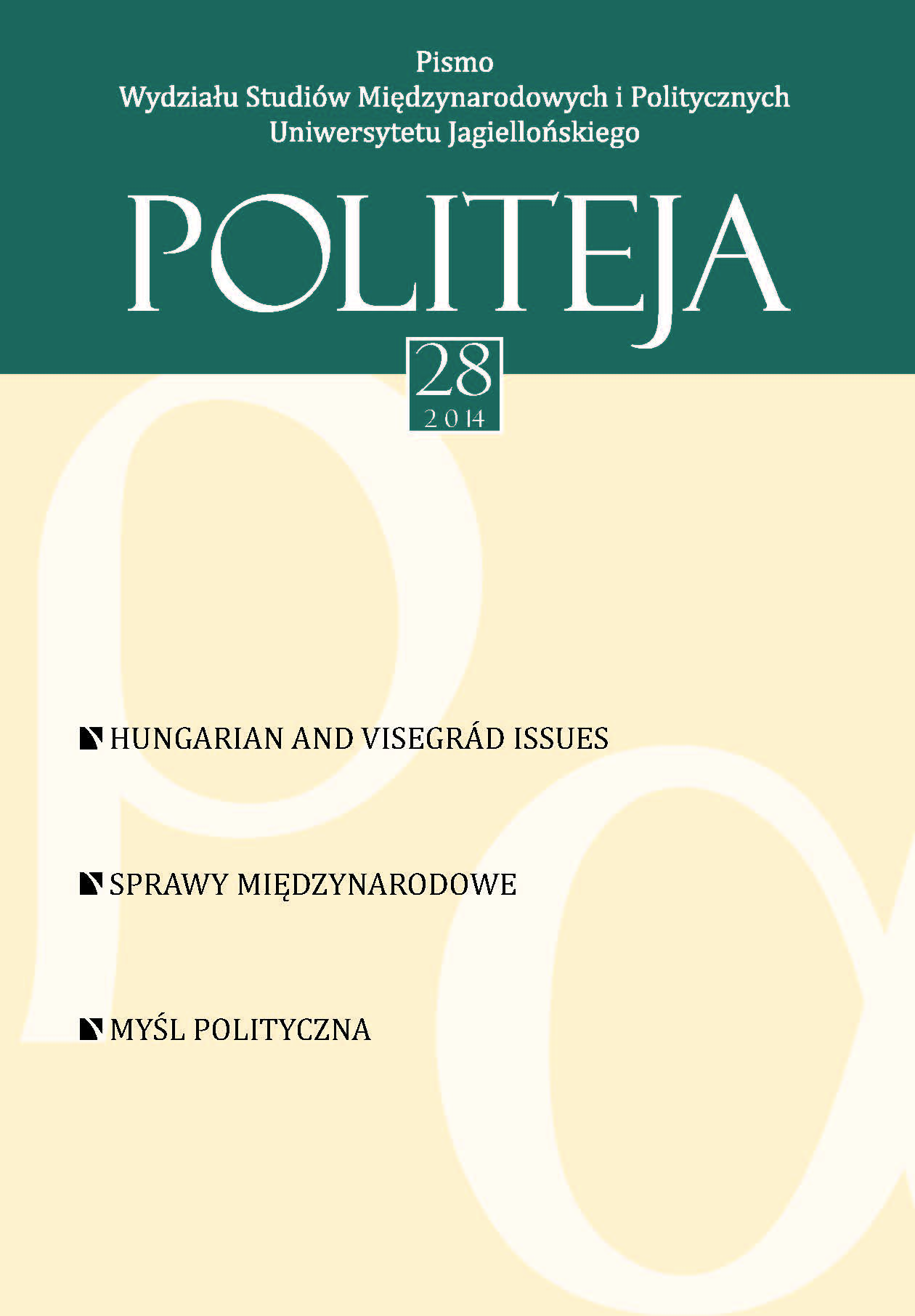The Visegrád Group – a model to follow?
DOI:
https://doi.org/10.12797/Politeja.11.2014.28.08Keywords:
European integration, Regional cooperation, West Balkans, Deepening, EnlargementAbstract
The Visegrád Group, based in particular to support the “return to Europe” of Central European countries, has resulted in a flexible framework for the implementation of cooperation at various levels. This framework was effective in the negotiation of the accession to the European Union. The group was maintained after the 2004 accession and the activities have evolved. Now, the V4 is an active regional group allowing the four countries to speak with one voice, both internally and externally. This raises the question of the structure of the European Union, specific confederation of 28 member states with complex governance, not always satisfactory. Two issues need to be explored: on the one hand, an extension of such regional alliances which could perhaps improve this governance, and, on the other hand, the establishment of regional alliances including some candidate countries (official and/or potential) could also make it possible to overcome the opposition between enlargement and deepening, and, secondly, to support the negotiations of countries while establishing a necessary environment of good neighbourliness.
Downloads
References
Official Documents Annex to the Content of Visegrad Cooperation, 2002, The Visegrad Group, at <http://old.visegradgroup.eu/main.php?folderID=941&articleID=9559&ctag=articlelist&iid=1>.
The Bratislava Declaration of the Prime Ministers of the Czech Republic, the Republic of Hungary, the Republic of Poland and the Slovak Republic on the occasion of the 20th anniversary of the Visegrad Group (Bratislava, 15 February 2011), The Visegrad Group, at <http://www.visegradgroup.eu/2011/the‑bratislava>.
Contents of Visegrad Cooperation 1999, The Visegrad Group, at <http://www.visegradgroup.eu/cooperation/contents‑of‑visegrad‑110412>.
Declaration of Prime Ministers of the Czech Republic, the Republic of Hungary, the Republic of Poland and the Slovak Republic on cooperation of the Visegrad Group countries after their accession to the European Union, 12 May 2004 (The Kroměříž Declaration), The Visegrad Group, at <http://www.visegradgroup.eu/2004/declaration‑of‑prime>.
Program slovenského predsedníctva vyšehradskej skupiny – V4 (Júl 2010 – Jún 2011), Efektívny Vyšehrad – kontinuita, súdržnosť, solidarita, informovanosť, at <http://www.visegradgroup.eu/download.php?Docid=137?>. Vyšehradská spolupráca, Ministerstvo zahraničných vecí a európskych záležitostí Slovenskej republiky, at <http://www.foreign.gov.sk/sk/zahranicna__politika/vysehradska_spolupraca‑vysehradska_spolupraca>.
Bilčík V., Strážay T., Fungovanie Vyšehradskej štvorky pred a po vstupe jej členov do Európskej únie, Bratislava 2006, Výskumné centrum Slovenskej spoločnosti pre zahraničnú politiku, at <http://www.sfpa.sk/dokumenty/publikacie/116>.
Brusis M., ‘Prospects of Visegrad Cooperation in an Enlarged European Union’, in Visegrad Countries in an Enlarged Trans‑Atlantic Community, ed. by M. Šťastný, Bratislava 2002.
Čajka P., Terem P., Iždinský D., The Dynamics of the Transformation Processes in Central Europe (The Czech Republic, Hungary, Poland), Banská Bystrica 2008.
Havel V., ‘The Visegrad Dream Still Relevant Today’, in The Visegrad Group – A Central European Constellation, ed. by A. Jagodziński, Bratislava 2006, International Visegrad Fund, at <http://visegradfund.org/wordpress/wp‑content/uploads/download/Central_European_Constellation.pdf>.
Kollár M., Mesežnikov G., eds., Slovensko 2002. Súhrnná správa o stave spoločnosti, Bratislava 2002, Edícia Slovensko v Pohybe.
Kořan M., ‘Visegrádská spolupráce, Rakousko, Polsko a Slovensko v české zahraniční politice’, in idem (ed.), Česká zahraniční politika v roce 2008. Analýza ÚMV, Praha 2009.
Koudar J., Visegrádská skupina po vstupu jejích členů do Evropské unie (Thesis/Dissertation), Brno 2012, Masarykova univerzita, Fakulta sociálních studií, at <http://is.muni.cz/th/263401/fss_m/>.
Lukac P., ‘Pourquoi les Slovaques ont‑ils besoin de Visegrád? Dossier “Slovaquie, le poids des héritages”’, Regard sur l’Est (1 May 2000), at <http://www.regard‑est.com/home/breve_contenu.php?id=124>.
Lukáč P., ‘Regionálna spolupráca v strednej Európe na začiatku 21. storočia – nové podoby a nové výzvy’, in Ročenka zahraničnej politiky Slovenskej republiky 2001, ed. by A. Kotvanová, A. Szép, Bratislava 2002.
Lukáč P., Vyšehradská štvorka, Banská Bystrica 2004.
Michault M., Le groupe de Visegrad a‑t‑il encore une utilité? (9 November 2006), Nouvelle Europe, at <http://www.nouvelle‑europe.eu/node/45>.
Sladičeková E., “Inštitucionálny” vývoj vyšehradskej spolupráce, jej možnosti, limity a perspektívy (bakalarka praca), Brno 2009, Masarykova univerzita, Fakulta sociálních studií, at <http://is.muni.cz/th/273908/fss_b/bakalarka_praca.pdf>.
Strážay T., ‘Inspirující Visegrád alebo Výročné zamýšleni nad možnost’ami exportu visegrádskkého modelu’, Mezinárodní politika, No. 3 (2011), at
cz/article/inspirujici‑visegrad‑alebo‑vyrocne‑zamyslenie‑nad‑moznostami‑exportu‑visegradskkeho‑modelu>.
Strážay T., ‘Vyšehrad 2008: dynamická regionálna platforma s pridanou hodnotou pre EÚ’, in Ročenka zahraničnej politiky Slovenskej republiky 2008, ed. by P. Brezáni, Bratislava 2009.
Vykoukal J. [et al.], Visegrád. Možnosti a meze středoevropské spolupráce, Praha 2003, Edice Bod.
Downloads
Published
Issue
Section
License

This work is licensed under a Creative Commons Attribution-NonCommercial-NoDerivatives 4.0 International License.






